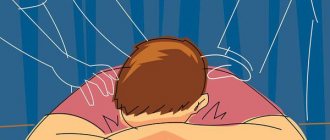Schizoid personality disorder is characterized by withdrawal, avoidance of emotional attachments, tendency to fantasies, and immersion in one's own inner world. People who suffer from schizoid disorder have difficulty communicating and making social connections. The help of a psychotherapist allows you to soften the sharp edges of interaction with the outside world.
Important
Self-isolation, which interferes with life and work, is a reason to consult a psychotherapist.
It is no coincidence that the word “schizoid” is consonant with schizophrenia: the manifestations of a schizoid disorder are similar to the symptoms observed in patients with schizophrenia: isolation, peculiar thinking (due to the fact that a person is constantly alone with himself), emotional coldness, callousness.
However, with this disorder, a person adequately perceives reality (there are no delusions or hallucinations). Schizoid disorder is a character trait, a tendency to avoid interaction with the outside world through voluntary social isolation, withdrawal into oneself and one’s own fantasies.
What is schizoid personality disorder (SPD)?
Schizoid personality disorder (SPD) is a pathological condition manifested by a combination of disharmonious characteristics of an individual, included in the DSM-5, ICD-10 and CCMD-3 classifiers.
They determine the personality structure, often congenital or acquired during life. Features of SPD are a tendency to immerse oneself in one's own fantasies, emotional alienation. Prevalence in the population is 3-5% (according to DSM-5). The final definition was introduced by Ernst Kretschmer in 1921. A German psychiatrist suggested a causal relationship between this personality disorder and schizophrenia. However, further foreign studies refute the theory. Domestic guidelines indicate that before the onset of the disease, approximately 40% of people had SPD.
Currently, the term “schizoid” is descriptive exclusively for this syndrome, that is, it is not identical to “schizophrenia.”
Facial expressions are devoid of liveliness and are limited to a set of standard expressions. The voice is little modulated, which is why the conversation is often conducted as if on one note. Clothing is stylized - it is either emphasized sophistication, aristocracy, or, conversely, deliberate negligence. Schizoids are people of extreme feelings and emotions; they either admire or hate. The hobbies of schizoids are most often peculiar, even original, and, as a rule, one-sided. The social significance of hobbies varies: for some, all their strength, thoughts and energy are directed towards achieving unimportant goals (for example, collecting); others, on the contrary, show remarkable energy and perseverance in creating sometimes very talented and valuable scientific concepts. However, in both cases, they remain completely indifferent to the needs of practical life, everyday interests, and the needs of the family.
Smulevich A.B. ‹‹Borderline mental disorders›› Schizoid personality disorder.
Treatment and therapy
Psychoanalytic
Therapy for schizoid personalities, in general, is relatively comfortable for psychoanalytically oriented therapists. One of the possible difficulties that can be expected is the transition of the dialogue with the client to an abstract-theoretical level, too divorced from reality. Schizoids themselves are prone to this, and the therapist can also become carried away by this manner of communication. Meanwhile, persistently demanding from a schizoid client that he “explain himself normally” is unacceptable, since a therapist who is unable to accept the client’s extraordinary way of thinking is perceived by the schizoid as not empathic and not interested in him.
Common problems that arise when working with a schizoid client relate, predictably, to issues of distance between the client and the therapist.
Despite the relative emotional comfort, psychoanalytic therapy for schizoid individuals takes a long time and causes many difficulties.
Causes
It is impossible to identify the exact reasons for the formation of a schizoid personality type; research is still ongoing. The following risk factors are expected:
- genetic, that is, congenital, characteristics of the individual;
- the presence of any mental spectrum disorders in close relatives - the theory of hereditary predisposition;
- environmental factors - social status, local mentality, characteristics of growing up;
- the nature of the relationship of parents or guardians to the child in the process of personality formation;
- the cumulation of experiences from early childhood to the present - stress, fear, loneliness, neglect from others, any type of violence.
It is not possible to talk about a single etiology, since the topic remains poorly studied even in a professional environment. Therefore, you should not specifically look for the most “convenient” reasons that explain the characteristics of a particular person.
Each clinical case should be reviewed by a psychiatrist, who will be able to determine the individual set of prerequisites that served as the impetus for the formation of SPD.
Diagnostics
To make a diagnosis, specialists use special tests, as well as diagnostic criteria. Schizotypal disorder is detected when 4 signs from this list are present:
- indifference to surrounding people and events, asociality;
- increased irritability, especially when meeting new people;
- causeless outbursts of anger;
- eccentric behavior or predilection for “strange” clothing;
- the presence of one’s own obsessions, often contrary to generally accepted norms, as well as inadequate thinking;
- excessive suspicion bordering on paranoia;
- adolescents may experience sexual disorders;
- incoherent speech, visual and auditory hallucinations;
- communication with fictional characters or non-existent people.
When meeting a patient, the psychotherapist conducts an initial examination and also has a long conversation with him. All this makes it possible to identify disturbances in thinking and perception characteristic of schizotypal disorder. If these manifestations are observed in a patient over a long period, then there is a high probability that he will be diagnosed with schizotypal disorder.
Signs and symptoms of the disorder
Clinical signs of schizoid disorder are not always the same, since individuals are formed under the influence of different environmental factors. A person with SPD may have the following traits:
- decreased or lack of emotional understanding – weak empathy;
- is more respectful of other people's personal boundaries;
- interests and hobbies are related to solitude;
- reluctance to maintain active social contacts;
- care little about the opinions of others, but prefer honesty, pragmatism, and sincerity;
- does not like excessive attention;
- prefers non-contact forms of communication;
- does not tolerate talking about “nothing”, lies, hysterics;
- self-sufficiency in introversion, loneliness, isolation;
- tendency towards introspection - “immersion in oneself”;
- awkwardness, discomfort in the presence of a large number of people;
- a tendency to choose theoretical, exact professions, as well as those related to art and philosophy;
- non-standard, eccentric behavior - a strange choice of clothing for most, indifference to praise or criticism, a different perception of banal things from others;
- less sensitive - physical touch does not bring much pleasure;
- often, but not always, a weak sexual constitution, low sexual activity;
- there is no paranoia, distorted perceptions or cognitive impairment.
Social distancing is seen as a protective mechanism. People of this type often have a richer world of their own fantasies, developed abstract thinking, and a special perception of things invisible to others. They often prefer the company of animals, solitude in nature, and quiet places to live. A striking example of schizoid personalities are the following characters: Sherlock Holmes, Gregory House or Batman.
In men
Such men give the impression of being dispassionate loners, devoid of a sense of humor. At the same time, they are able to maintain a sufficient level of social activity, which is required for work or normal life activities.
Unlike autistic disorders, schizoids understand the emotions and feelings of other people, but do not strive for them, as they experience discomfort.
Outwardly “cold” behavior does not mean a lack of desire for at least minimal affection. Schizoids rarely marry, but from time to time they can find partners who respect their emotional boundaries. At the same time, they are more sensitive to separation, experience it more acutely and longer.
Among women
According to Russian guidelines, the schizoid personality type is half as common in women as in men (1:2). American classifiers (DSM-IV, DSM-5) do not provide reliable epidemiological data. The exact prevalence of SPD in the population is unknown, let alone the strong gender differences.
Schizoid women are full of contradictions. Feeling self-sufficient in their detachment, they may need a partner. On the surface they are unemotional, but inside they are impulsive, bright, imaginative personalities.
The priority in the life of such girls is not marriage, but personal comfort. They choose calm men or women who respect introversion. Often, schizoid individuals prefer impersonal sexual contacts by agreement, not allowing anyone to approach their inner “I”.
Story
The term “schizoid” was first used by Bleuler (1924), who described a “closed,” suspicious, sad person whose energy is directed inward rather than outward. This individual also demonstrated social withdrawal and odd thinking, but was not psychotic (Siever & Gunderson, 1983). A few years earlier, Hoch (1909) also described a “closed” personality that preceded the development of schizophrenia. The personality of these patients in the premorbid period was characterized by a tendency to solitude, shyness, stubbornness and rich imagination. Hoch and Polatin (1939) later described this group of nonpsychotics predisposed to developing schizophrenia as “pseudoneurotic schizophrenics.” Nannarello (1953) reported that the term was later popularized by Kretschmer (1925), who described “affective impairment” in two types of schizoid personality, “hyperaesthetic” and “anesthetic.” Kretschmer described the anesthetic schizoid personality as a dull, colorless, quiet, withdrawn person who rarely or does not show his emotions and interests.
In contrast, hyperaesthetic people are shy and so sensitive to external stimuli that they try to avoid them at all costs. From Kretschmer's point of view, a schizoid diagnosis does not necessarily equate to disability. Millon (1981) suggests that in modern terminology, the hyperaesthetic type would correspond to avoidant personality disorder, and the anesthetic type would correspond to schizoid personality disorder.
As noted by Siever & Gunderson (1983), the term "schizoid" has expanded from its original meaning to include people who avoid relationships and social interactions and tend to be eccentric. Widespread use of the term has overshadowed its original meaning as a non-psychotic form of schizophrenia. But it was not until 1953 that Raido coined the term "schizotypal" as short for "schizophrenic genotype." He was referring to people who he believed were genetically predisposed to schizophrenia but did not exhibit psychotic behavior. Rado's description of a schizotypal person included complete indifference to the joys of life, emotional coldness, impaired empathy and dependence. Although Raido intended to describe a non-psychotic form of schizophrenia, his description (apart from addiction) is very similar to the modern diagnosis of schizoid personality disorder.
Meehl (1962) later described a personality type similar to schizotypal personality disorder, which he believed was genetically related to schizophrenia. This group was characterized by cognitive decline, withdrawal from social contacts, complete indifference to the joys of life and ambivalence. This personality type typically showed low levels of adjustment, but eccentricity in thinking, behavior, and emotions, as described by Meehl, were not the main characteristics of this disorder. Kety, Rosenthal, Wender, & Schulsinger (1968) described “borderline schizophrenia,” also similar to schizotypal personality disorder, as a nonpsychotic personality disorder involving cognitive distortions, complete indifference to the joys of life, emotional coldness and lack of interpersonal skills. Siever and Gunderson (1983) note that this personality type is characterized by a paucity of interpersonal relationships rather than by social isolation and withdrawal (consistent with modern diagnoses of avoidant and schizoid personality disorders).
Because of the vagueness of these disorders and the changes in views on them over the years, the corresponding diagnoses have changed over time. In the DSM-I, schizoid personality was characterized by avoidance of relationships with others, an inability to express hostility or aggressive feelings, and autistic thinking. This description of a cold, emotionally detached, timid personality who could exhibit eccentricities appears to fit modern diagnoses of avoidant, schizoid, and schizotypal personality disorders. It was only in DSM-III that these disorders were separated. When developing new criteria, Millon (1969) emphasized the difference between the two personality types. He labeled them the “passive-avoidant” and “active-lonely” types or the “asocial” and “avoidant” types, which correspond to the modern diagnoses of schizoid and avoidant personality disorders (Millon, 1981). Although the term "schizoid" has a complicated history, it has remained a label for "asociality." This was supposed to be different from antisocial personality disorder. The schizotypal pattern, also included in the DSM-I and DSM-II descriptions of schizoid personality, was considered a separate personality type. Schizotypal and borderline personality types were then distinguished (Spitzer, Endicott, & Gibbon, 1979).
While early theorists such as Bleuler and Kretschmer believed that schizoid personality was due to constitutional problems, later psychoanalytic theorists hypothesized that schizoid character structure resulted from serious disturbances in the mother-child relationship. In psychoanalytic terms, as a result of these early disturbances, the schizoid person developed a primary defense structure in which relationships were avoided due to an inability to give or receive love. Moreover, this type of patient was thought to be so vulnerable to rejection that the value of relationships with people was suppressed (Arieti, 1955). Fairbairn (1940) reported that the result of these unsatisfying maternal relationships was the development of depersonalization and an artificial self in which feelings were repressed. The schizoid personality is unable to experience love and intimacy. Klein (1952) viewed the schizoid process as a developmental stage that all children go through. During this stage, oral and sadistic urges, experienced as dangerous, are separated and projected onto the caregiver. In this case, the caregiver is considered dangerous, and various defenses are formed to overcome the anxiety that arises in this regard. The schizoid adult, retaining some of these early defenses, maintains distance in interpersonal relationships due to anxiety caused by interpersonal contacts. Guntrip (1969) also described developmental delays in early life when children avoid an unsatisfying relationship with their mother. These people subsequently develop a primitive fear of consuming people or being consumed by a caregiver. This leads them to develop a reserved and aloof interpersonal style as a defense against primary horror and anger.
Psychoanalytic theorists, in addition to distance in interpersonal relationships, also pay attention to the defensive, detached, “observer” style seen in schizoid individuals. Deutsch (1942) reported that an “as if” personality is formed, so it is impossible to feel emotions. The observer may see that the life of schizoids “seems” to be fulfilling, but upon closer examination, a lack of emotional reactivity will be obvious.
In contrast to the complex intrapsychic mechanisms proposed in psychoanalysis, Millon (1981) stated that the schizoid personality has a relatively simple defense structure. He believes that schizoid people suffer from a lack of ability to form relationships and experience emotions. As a result of this insensitivity to interpersonal contacts and emotional stress, there is no need to develop defenses.
How is a schizoid character formed?
Schizoid trauma usually occurs in the first months of a child's life. Scientists conducted observations and found that immediately after birth, a baby is already capable of quite meaningful interaction with the people who surround him. Babies can distinguish the voices of those who care for them, see their faces at close range, and can even read the emotional mood of an adult - sadness, joy, kindness, anger. When an adult is in a positive emotional state, the baby will be calm; if the adult is angry or indifferent, the child will distance himself from him at the level of instincts.
Of course, adults can be in different moods - fatigue and lack of sleep do not allow the baby’s parent to constantly be in a joyful state. Today the parent is tired or upset, tomorrow he is cheerful and cheerful. Seeing these changes, the baby calms down.
But if for many months in a row a child is faced with indifference, coldness or anger, and there is little or no kind attitude, trauma occurs.
Why is coldness and indifference so terrible for a child? An adult, seeing that he is not welcome, can leave, ask why, and try to cheer him up. The baby’s psyche is still primitive, and of course he cannot go anywhere, so the only way out is withdrawal - exclusion from interaction.
In addition, for the development of the psyche, a child needs communication with an adult. It is the adult who must teach the child to deal with emotions. If this does not happen, the baby begins to block his natural emotional reactions. The child tries to attract attention to himself as little as possible, restrain himself, go into the shadows, so as not to cause a new outbreak of anger in adults. Consequently, his psyche remains at the level of primitive affects - rage and horror. A person cannot be constantly terrified, so he turns on primitive psychological defenses - withdrawal from reality, isolation of affect, repression.
Object relations
The subjective life of schizoids is permeated with ambivalence regarding attachment. They crave intimacy even though they feel threatened by others. They seek distance to maintain their safety, but at the same time suffer from remoteness and loneliness.
The message of schizoids to the world looks something like this: “Come closer, I’m lonely, but stay at a distance, I’m afraid of being absorbed by you!”
These people are often indifferent to sex, but are able to have an orgasm; physiologically they are completely healthy. Selective in choosing partners, it takes more time to “warm up”. The closer the other person is, the more they perceive that sex means a trap. They are wary of any new connections. However, they may desire unattainable sexual objects, but are indifferent to the available ones.
The upbringing of these individuals could proceed in the pattern of “a schizoid man and an over-caring, suffocating mother.” Mom, most likely, “ruled the show” and controlled all processes in the family. A boundary-violating mother and an impatient, critical father. The child may be in a state of double clamping and emotionally false messages. We depend on care to protect our own “I” from approaching them. The double clamp manifests itself in the fact that one message is demonstrated verbally, and the child perceives another non-verbally. "I love you very much!" mother tells her little son, who has been waiting for her from work for a long time. And non-verbally, she strives to quickly complete communication with him simply because she is tired. The child is confused about which signal to perceive as reliable.
The childhood of schizoids is characterized by loneliness and isolation. Parents are distant, manifest themselves as oppressive and intruding, and a pattern of avoidance, distancing, and detachment is formed. Such children, and subsequently people, do not like to openly discuss their thoughts with someone or share their impressions. They do not like attention from society.
Psychological help
Psychotherapy is used to treat schizoid accentuation. The psychoanalytic approach, which involves long-term work by a psychologist, helps well. The specialist must act carefully, reducing the distance very gradually. You cannot focus the patient’s attention on his characteristics or emphasize his originality. To achieve the schizoid's favor, a demonstration of acceptance of his non-standard thinking is necessary.
Group therapy also works well; in these classes, individuals learn to accept themselves through the example of studying people like themselves. The environment should be as comfortable as possible and based on a feeling of complete safety. Of course, not all schizoid personalities can open up in the presence of strangers, but if you conduct such classes regularly, you can gradually achieve their participation in therapy.
Cognitive therapy is based on the experience of positive emotions. In this case, the patient must study the entire range of feelings and learn to understand each of them. Next, he must practice expressing positive emotions in life situations, as well as building friendly contacts. You need to start this kind of work in a familiar environment, but gradually leave your comfort zone.
To live comfortably next to a schizoid woman, and to communicate meaningfully with her, you need to find an approach to her. Treatment of people with the schizoid type is necessary only in cases where they have difficulties with social adaptation, problems with professional activities and personal life. In most cases, correction is not necessary.










